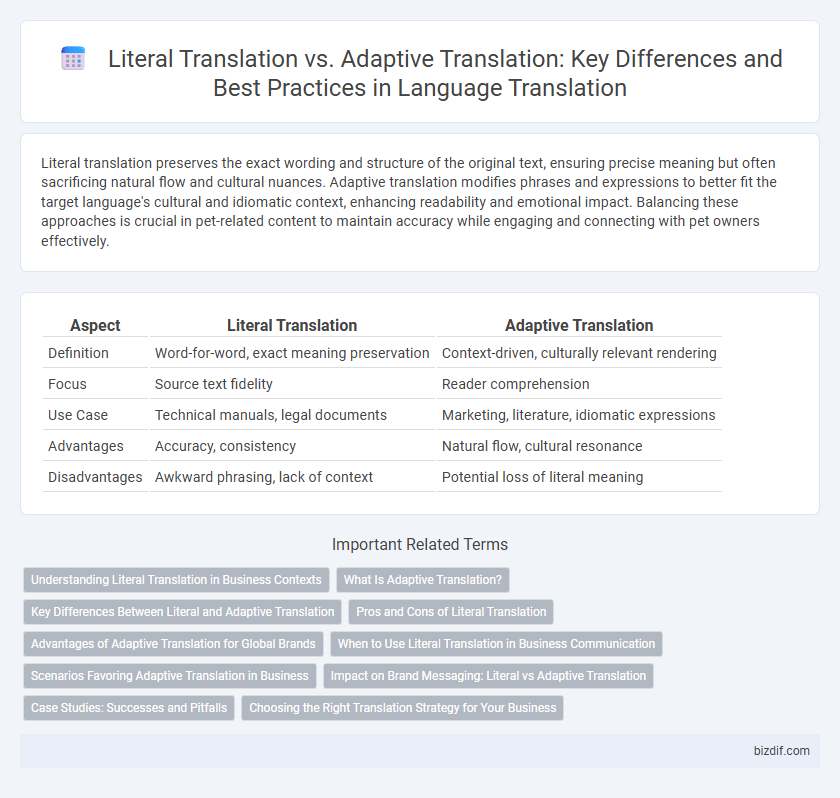Literal translation preserves the exact wording and structure of the original text, ensuring precise meaning but often sacrificing natural flow and cultural nuances. Adaptive translation modifies phrases and expressions to better fit the target language's cultural and idiomatic context, enhancing readability and emotional impact. Balancing these approaches is crucial in pet-related content to maintain accuracy while engaging and connecting with pet owners effectively.
Table of Comparison
| Aspect | Literal Translation | Adaptive Translation |
|---|---|---|
| Definition | Word-for-word, exact meaning preservation | Context-driven, culturally relevant rendering |
| Focus | Source text fidelity | Reader comprehension |
| Use Case | Technical manuals, legal documents | Marketing, literature, idiomatic expressions |
| Advantages | Accuracy, consistency | Natural flow, cultural resonance |
| Disadvantages | Awkward phrasing, lack of context | Potential loss of literal meaning |
Understanding Literal Translation in Business Contexts
Literal translation in business contexts involves converting text word-for-word from one language to another, preserving the original structure and terminology without altering meaning. This method ensures technical accuracy and consistency, especially in contracts, legal documents, and product specifications where precise wording is crucial. However, it may lack cultural nuances and idiomatic relevance, potentially affecting clarity in marketing or customer-facing materials.
What Is Adaptive Translation?
Adaptive translation involves modifying the source text to better suit the cultural context, idiomatic expressions, and audience preferences of the target language. It prioritizes conveying the intended meaning and emotional impact over a word-for-word rendering, ensuring the translation resonates naturally with readers. This approach enhances clarity, engagement, and relevance by tailoring content to the specific linguistic and cultural nuances of the target market.
Key Differences Between Literal and Adaptive Translation
Literal translation maintains the exact wording and structure of the source text, ensuring high fidelity but often sacrificing natural flow and cultural nuance. Adaptive translation prioritizes conveying the intended meaning and context, resulting in a more fluid and culturally relevant output that resonates with the target audience. Key differences include accuracy versus readability, direct word-for-word rendering versus contextual interpretation, and the balance between source content preservation and audience engagement.
Pros and Cons of Literal Translation
Literal translation preserves the original text's structure and meaning, ensuring accuracy and consistency, which is crucial for technical or legal documents. However, it often results in unnatural phrasing and may fail to convey cultural nuances, reducing readability and engagement for the target audience. This approach risks misunderstanding when idiomatic expressions or context-specific terms are translated word-for-word.
Advantages of Adaptive Translation for Global Brands
Adaptive translation enhances brand messaging by tailoring content to resonate with diverse cultural nuances, increasing global consumer engagement. This approach improves market relevance and emotional connection, fostering stronger brand loyalty across regions. Leveraging adaptive translation reduces the risk of misinterpretation and cultural insensitivity, protecting brand reputation internationally.
When to Use Literal Translation in Business Communication
Literal translation is most effective in business communication when accuracy and consistency of technical terms, legal documents, or standardized content are crucial to maintain the original meaning. It ensures that specific jargon and contractual language are preserved without alteration, minimizing misinterpretation risks in international agreements. Literal translation is also preferred when the target audience is familiar with the source language structure, facilitating clear and direct information exchange.
Scenarios Favoring Adaptive Translation in Business
Adaptive translation excels in business scenarios where cultural nuances and localized market preferences impact consumer engagement and brand perception. It ensures messaging is tailored to resonate with target audiences, enhancing customer experience and driving conversion rates. This approach is essential for marketing materials, product launches, and customer support content that require contextual relevance beyond word-for-word accuracy.
Impact on Brand Messaging: Literal vs Adaptive Translation
Literal translation preserves exact wording but risks losing cultural nuances, which can dilute brand messaging and confuse target audiences. Adaptive translation tailors content to cultural contexts, enhancing emotional connection and strengthening brand identity. Selecting adaptive translation ensures brand messages resonate effectively across diverse markets, driving engagement and loyalty.
Case Studies: Successes and Pitfalls
Case studies reveal that literal translation excels in legal and technical documents where precision is critical, minimizing misinterpretation risks. Adaptive translation proves successful in marketing and literature, enhancing cultural relevance and audience engagement but may introduce inaccuracies if local context is misunderstood. Both approaches show pitfalls, such as losing nuance in literal methods and risking message distortion in adaptive practices, underscoring the need for context-aware strategies.
Choosing the Right Translation Strategy for Your Business
Choosing the right translation strategy for your business depends on balancing accuracy with cultural relevance. Literal translation maintains the original text's structure and meaning but may miss nuances important for target audiences. Adaptive translation, also known as localized translation, tailors content to resonate with local culture and consumer behavior, enhancing engagement and market effectiveness.
Literal Translation vs Adaptive Translation Infographic

 bizdif.com
bizdif.com